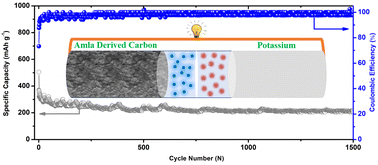A high performance and long-cycling bi-functional carbon electrode derived from Phyllanthus emblica (amla) for potassium ion batteries and supercapacitors†
Abstract
Developing low-cost electrodes for energy storage devices with high energy and power densities remains a daunting problem. Herein, interconnected porous carbon is created using the Phyllanthus emblica (amla, also known as Indian gooseberry) fruit as a precursor and KOH as an activating agent by a simple carbonization method combined with chemical activation. The activated amla-derived carbon (AAC) has a large specific surface area (up to 1661 m2 g−1) and a hierarchical porous structure with mesopores. Furthermore, the large interlayer spacing (0.367 nm) and the residual elements (N and O) in the porous carbon structure substantially enhance the conductivity and reaction activity. The AAC showed a high reversible capacity of 295 mA h g−1 at 100 mA g−1, as well as remarkable rate properties and good cycling life stability (210 mA h g−1 after 1500 cycles at 1000 mA g−1) with 99.8% coulombic efficiency, when evaluated as an electrode material for potassium ion batteries. The AAC electrode in a symmetric supercapacitor device exhibited a remarkable specific energy of 57.5 W h kg−1 at a specific power of 300 W kg−1 in an organic electrolyte (1 M TEABF4/AN) with a wide voltage window of 0.0–3.0 V. Moreover, it retained a specific energy of 25 W h kg−1 even at a high specific power of 3000 W kg−1, indicating its high-rate capability. Furthermore, it exhibited an excellent efficiency of 97.3% over 10 000 charge–discharge cycles.



 Please wait while we load your content...
Please wait while we load your content...